
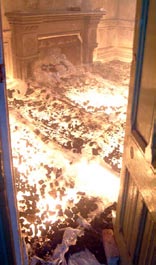
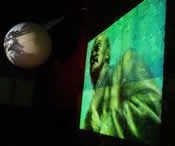

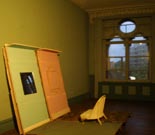
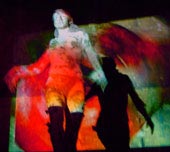
Curating an exhibition of mixed media site-responsive work by different artists in a semi-derelict, Grade A listed space was never going to be an easy task. The plethora of rules and regulations pertaining to the listed status, combined with the delicate condition of much of the building, particularly the fragile upper floor, meant that any trusted protocols and procedures that a gallery curator may have to hand must be immediately thrown out of the window. Fortunately, experience and imagination together combined to make the process if never easy, at least achievable.
With The Derelict Sensation, Luna Nera developed the project in conjunction with Grand Productions, an organisation aligned to the owners, London and Continental Railways, concerned with holding events in the St Pancras building, and a website derelictsensation.com, which showcases writing and photography about derelict spaces. Grand had managed commercial and corporate events in the space, but no art exhibition, while derelictsensation.com was interested in promoting a live event to break out of the "virtual" environment of the web.
In curating the exhibition, I knew, as curator and simultaneously member of Luna Nera, that in an environment so sensitive and with a timescale so short, it was imperative to choose artists who had experience of working site-responsively and in non-traditional environments. It was important to find artists who understood how to choose space, how to respond to the space, how to create work that would be able to be set up and run in the space with minimum fuss and - given the tight budget - to do without the technical support a gallery would provide.






Berlin-based artist group T.R.O. and Jenny Brockmann of organisation OrtKultur understood this imperative well, based on their own experience of working in Berlin's derelict industrial spaces. These artists, together with Luna Nera, provided the guiding structure of procedure, and the other artists selected were able to follow their lead.
In this way the project was collaborative in a way group shows rarely are. While each artist created and presented their own work, the experience of being together in their overwhelming yet very restrictive space meant that the artists needed to communicate and work together to create a collective environment of wonder. The tightness of the theme "the derelict sensation" also served to concentrate the attention of the artists, to help them focus their work and allow all the artists to negotiate the relationship between their works and those of the other participants. The result was a unity that overcame the jumble that is the hallmark of most group shows.
The difficulties with the building were many: there was no provision of electricity on the upper floor , so a temporary install was required. The time frame was also extremely pressed: four days altogether for installation of works, exhibition and removal. Problems overcome, the two-day event attracted over 1,000 visitors - which must be some kind of record for a show that (deliberately) did not feature any "big name" artists or use any paid advertising. The success of the project lay in the collaborative attitude of the participating artists, to create an integrated, atmospheric live art event which the visitors felt from the moment they entered through the port-cochere.
The title of the show was Derelict Sensation and so the aim was to create a multisensory, lived, interactive experience out of a little-known, cobwebbed derelict building.
Attracting so many visitors from a jaded London public was an achievement. Much of this, it must be said was down to the fact that the exhibition offered the unique experience of being able to enter one of the most mysterious buildings in London. Every person who passed along the Euston Road, or travels via the adjacent stations, must have wondered what is that enormous red Gothic building? But the place has been mostly closed to the public since 1935.Opening this unknown and unknowable urban site to the public via art opened up more than the building.
It opened up the dialogue about the city and change - people suddenly saw the Kings Cross area as it might once have been more than a hundred years ago, before urban blight descended like a filthy cloak, obscuring the past glories of the railway age.
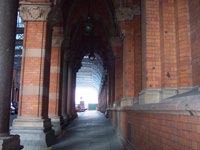
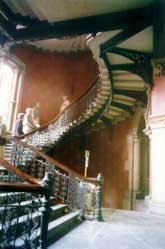
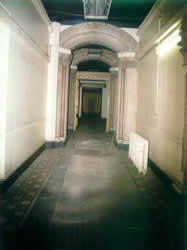
Gazing out onto the Euston Road from the Ladies Smoking Room, which featured an audio installation by Thunderbolt and a painting installation by Derek Szteliga of T.R.O., offered an opportunity to stand for a moment on the fault line between past and present. From the window, one could see the cranes and huge machines rebuilding the area into a showcase of architectural regeneration and post-modern transport. Inside the room, one heard the murmured conversation of 19th century ladies, and in the corner of the eye, a huge painting of the underwater interior of the Titanic -symbol of modernism and hubris.
The exhibition was held in the last months before the massive edifice began
its reconversion from derelict site into a grand hotel. By spring the big machines
had moved in and the slumbering red giant structure joined with the rest of
the Kings Cross area in preparing itself for the advent of the Channel hi-speed
rail link.
The Midland Grand Hotel reborn will be part of this.
Some expressed sadness that the magnificence of the Midland Grand in its ruined state would be lost by redevelopment. Luna Nera understood that it is entirely appropriate - and is the most desirable option - for the building to be restored to its original use in a contemporary setting. Very rarely does this happen to an urban stucture, so it was exciting to be able to be part of the transitional period. and we await the reopening of the new Midland Grand - or whatever it will be remaned - with anticipation.
It is too easy to romanticise the past, and derelict structures are very romantic places.
Similarly, because we open a place to art does not mean that we advocate or desire that place to become a permanent site for art. Art is and should be everywhere: the more temporary art sites in the city the better. While urban renewal is a feature of life in the modern city, it is all too often experienced passively by the citizens, who see cranes on the skyline and earthmovers rumbling, but have little other contact with the transformation. Yet a sense of ownership of the environment, a sense of familiarity with the cityscape, is essential to a feeling of belonging.
Dispelling the anomie of urban life is one of the tasks and responsibilities of the contemporary artist. As the 19th and 19th century artist's job was to re-present the environment back to the aristocratic or capitalist owners of the land, the contemporary artist's job – in a liberal democracy - is to involve and invoke the relationship between the citizens and their city.
Gillian McIver 2004
Participating Artists:
Luna Nera (Sandrine Albert, Ben Foot, Valentina Floris, Natasha Mayran, Gillian
McIver,Julian Ronnefeldt) UK
T.R.O. (Leo Koenigsberg, Denise Kluge, Christian Glass, Enzo Perin, Derek Szteliga)
BERLIN
Michael Alstad & Kelty McKinnon CANADA
Sumer Erek UK
Evgeny Strelkov RUSSIA
Helen Frosi UK
Lennie Lee UK
Thunderbolt (Zoe Riddell and Catrin Jones) UK
Liane Lang UK
Zoe Hodgson UK
Miranda Sharp UK
Joel Cahen UK
Laurent Louyer (Creatmosphere) UK
D/Kaf/Ka/f dance group UK
lighting designer Paul Gavin
The Midland Grand Hotel, St Pancras Station, London. Built by Sir George Gilbert Scott, begun 1868 completed 1877. Closed 1935. Now under restoration."While the hotel reveals the Victorian obsession with past styles, the train platform and shed by contrast illustrate the advances made in engineering technology during the period." RIBA
2004